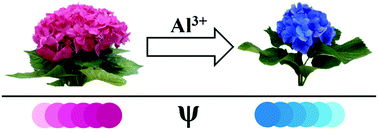Quantum chemical evidence for the origin of the red/blue colors of Hydrangea macrophylla sepals†
Abstract
Hydrangea macrophylla is noted for the variation of the color of its sepals from red to blue when they are planted in acidic, aluminum-containing soil. The major anthocyanin present in the colored sepals is 3-O-glucosyl delphinidin and its color change from red to blue is attributed to chelation with Al(III). The pigment responsible for the blue color may also involve an additional organic copigment such as 5-O-caffeoylquinic acid, forming a 1:1:1 ternary anthocyanin–Al(III)–copigment complex. In the present work, we have employed the algebraic diagrammatic construction method to second order, ADC(2), to predict the ab initio excited state energies and oscillator strengths in the gas phase and in aqueous solution (via COSMO) of the various species that can potentially contribute to the red and blue colors of Hydrangea macrophylla sepals. These species include the anthocyanin, binary anthocyanin–copigment complexes without Al(III), binary anthocyanin–Al(III) complexes without the copigment and ternary anthocyanin–Al(III)–copigment complexes. The predicted and experimental spectra of the anthocyanin itself are in good agreement, providing evidence for the predictive ability of the calculations. The calculated spectrum of one of the binary anthocyanin–copigment complexes is shown to be close to the experimental spectrum of red Hydrangea sepals. In contrast the predicted spectra of the binary and ternary Al(III)-containing complexes exhibit maxima at substantially longer wavelengths than those of red sepals, much closer to the experimental spectrum of blue sepals. Indeed, when the predicted spectra are converted to color coordinates and plotted on a CIE chromaticity diagram, the species without Al(III) fall into more red-like regions around that of free anthocyanin and the red sepals, while those involving complexation with Al(III) fall into more blue-like regions near to the blue Hydrangea sepals. Thus, the direct calculation of the colors of the species potentially present in Hydrangea sepals provides strong evidence for the crucial role of complexation between the anthocyanin and aluminum(III) as the decisive structural feature responsible for the occurrence of the blue color.



 Please wait while we load your content...
Please wait while we load your content...